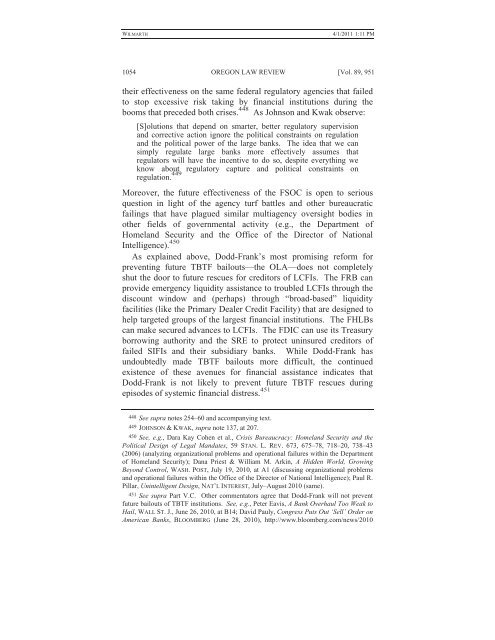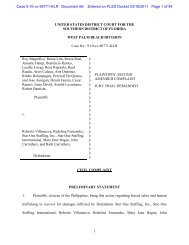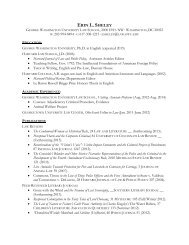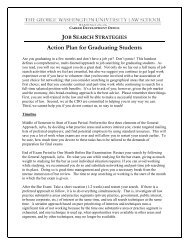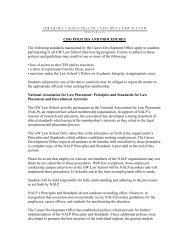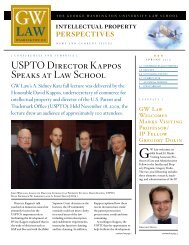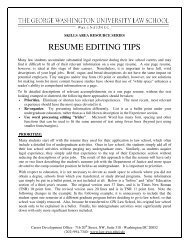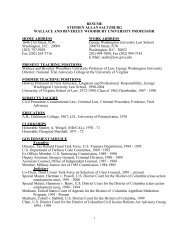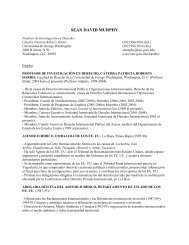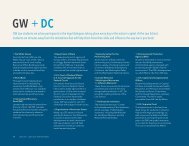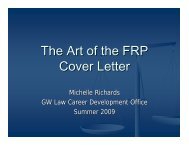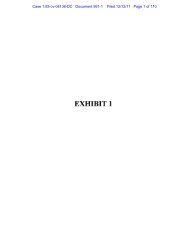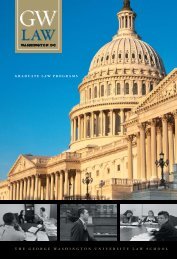CLE Materials for Panel #1 - George Washington University Law ...
CLE Materials for Panel #1 - George Washington University Law ...
CLE Materials for Panel #1 - George Washington University Law ...
You also want an ePaper? Increase the reach of your titles
YUMPU automatically turns print PDFs into web optimized ePapers that Google loves.
WILMARTH<br />
4/1/2011 1:11 PM<br />
1054 OREGON LAW REVIEW [Vol. 89, 951<br />
their effectiveness on the same federal regulatory agencies that failed<br />
to stop excessive risk taking by financial institutions during the<br />
booms that preceded both crises. 448 As Johnson and Kwak observe:<br />
[S]olutions that depend on smarter, better regulatory supervision<br />
and corrective action ignore the political constraints on regulation<br />
and the political power of the large banks. The idea that we can<br />
simply regulate large banks more effectively assumes that<br />
regulators will have the incentive to do so, despite everything we<br />
know about regulatory capture and political constraints on<br />
regulation. 449<br />
Moreover, the future effectiveness of the FSOC is open to serious<br />
question in light of the agency turf battles and other bureaucratic<br />
failings that have plagued similar multiagency oversight bodies in<br />
other fields of governmental activity (e.g., the Department of<br />
Homeland Security and the Office of the Director of National<br />
Intelligence). 450<br />
As explained above, Dodd-Frank’s most promising re<strong>for</strong>m <strong>for</strong><br />
preventing future TBTF bailouts—the OLA—does not completely<br />
shut the door to future rescues <strong>for</strong> creditors of LCFIs. The FRB can<br />
provide emergency liquidity assistance to troubled LCFIs through the<br />
discount window and (perhaps) through “broad-based” liquidity<br />
facilities (like the Primary Dealer Credit Facility) that are designed to<br />
help targeted groups of the largest financial institutions. The FHLBs<br />
can make secured advances to LCFIs. The FDIC can use its Treasury<br />
borrowing authority and the SRE to protect uninsured creditors of<br />
failed SIFIs and their subsidiary banks. While Dodd-Frank has<br />
undoubtedly made TBTF bailouts more difficult, the continued<br />
existence of these avenues <strong>for</strong> financial assistance indicates that<br />
Dodd-Frank is not likely to prevent future TBTF rescues during<br />
episodes of systemic financial distress. 451<br />
448 See supra notes 254–60 and accompanying text.<br />
449 JOHNSON &KWAK, supra note 137, at 207.<br />
450 See, e.g., Dara Kay Cohen et al., Crisis Bureaucracy: Homeland Security and the<br />
Political Design of Legal Mandates, 59 STAN. L.REV. 673, 675–78, 718–20, 738–43<br />
(2006) (analyzing organizational problems and operational failures within the Department<br />
of Homeland Security); Dana Priest & William M. Arkin, A Hidden World, Growing<br />
Beyond Control, WASH. POST, July 19, 2010, at A1 (discussing organizational problems<br />
and operational failures within the Office of the Director of National Intelligence); Paul R.<br />
Pillar, Unintelligent Design, NAT’L INTEREST, July–August 2010 (same).<br />
451 See supra Part V.C. Other commentators agree that Dodd-Frank will not prevent<br />
future bailouts of TBTF institutions. See, e.g., Peter Eavis, A Bank Overhaul Too Weak to<br />
Hail, WALL ST. J., June 26, 2010, at B14; David Pauly, Congress Puts Out ‘Sell’ Order on<br />
American Banks, BLOOMBERG (June 28, 2010), http://www.bloomberg.com/news/2010


